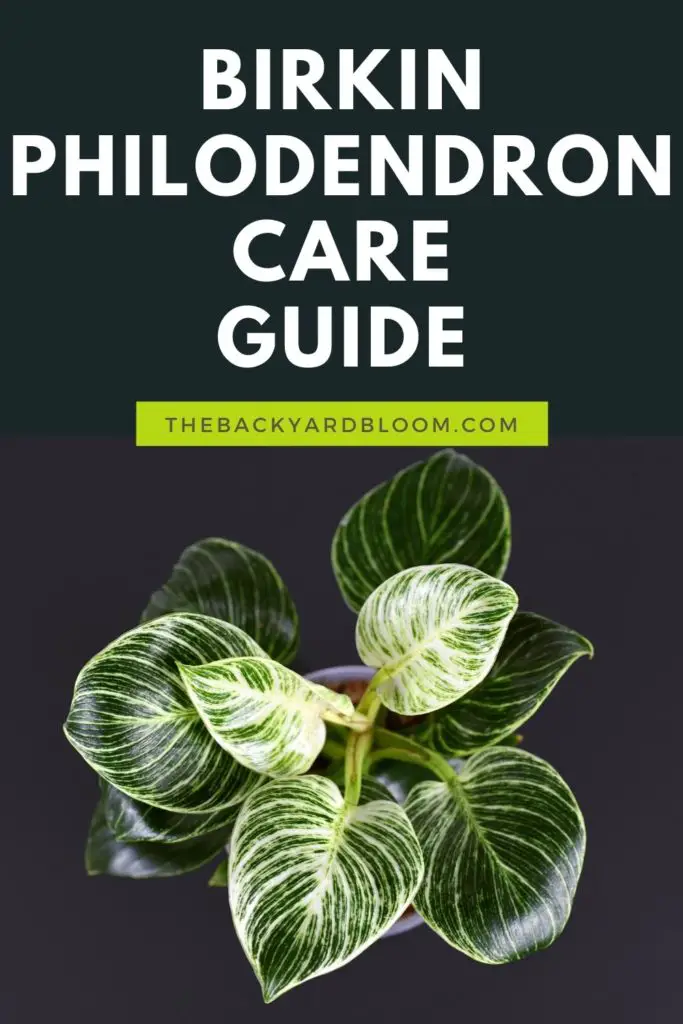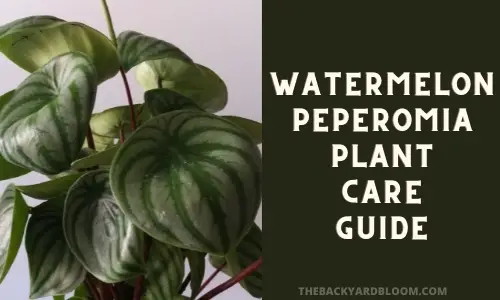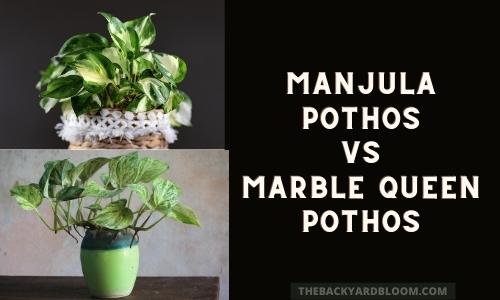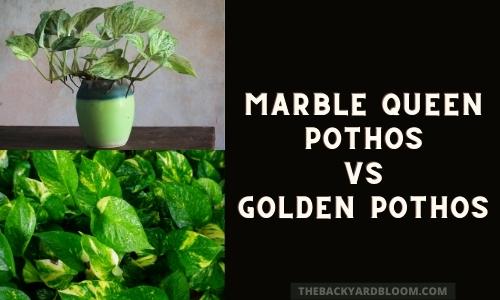Please note that this post may contain affiliate links. You can read my full affiliate disclosure at the bottom of the page.
Birkin Philodendrons are beautiful houseplants that are growing in popularity fast but are still relatively rare. With them being so new it has many people asking how do you take care of a Birkin Philodendron? In this care guide, we go over the care needed to let your Birkin Philodendron thrive and live a long life in your house.
Birkin Philodendrons have unique-looking leaves with variegation that remind people of a pinstripe making them stand out from other houseplants. Their leaves can grow up to 8 inches long and have some very unique variegation and the plant can get a couple of feet tall. This makes them a great unique plant for smaller spaces since you don’t have to worry about them taking over an entire area. They will require some attention to detail when it comes to watering and humidity levels. Read on to find out all the details of caring for a Birkin Philodendron.
- Origins of the Birkin Philodendron
- Other Names for Birkin Philodendron Plants
- Plant Care Guide for the Birkin Philodendron
- How To Water a Birkin Philodendron
- Birkin Philodendron Plant Light Requirements
- What Soil to Use with Birkin Philodendron Plants
- The Best Type of Pot for a Birkin Philodendron
- Repotting a Birkin Philodendron
- Birkin Philodendron Plant Propagation
- Birkin Philodendron Toxicity and Pets
- Fertilizing a Birkin Philodendron
- Temperature Needs
- Humidity
- Pruning Birkin Philodendron Plants
- Common Problems With Birkin Philodendron Plants
- Frequently Asked Questions About Birkin Philodendrons
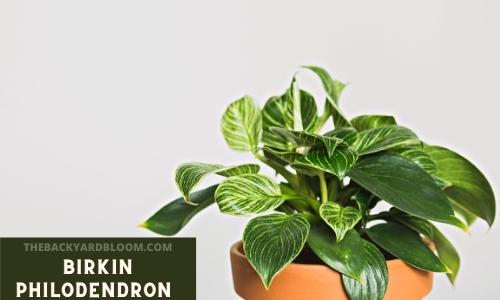
Origins of the Birkin Philodendron
This is a hybrid Philodendron with thick dark green leaves and bright white pinstripes, making it quite a unique-looking philodendron.
There are several accounts going around about the origins of the Birkin Philodendron. Unlike many other common Philodendrons people have at home, the Birkin Philodendron did not come from the wild.
The first is that the Birkin Philodendron a mutation found on the Philodendron Rojo Congo and upon being found, the leaf with the mutation was taken off the original plant and propagated.
The second account of the Birkin Philodendron is that it is a mutation, but this time it is a mutation from a hybrid between the Roho Congo and a Green Imperial Philodendron.
No matter which way the mutation has come about, it has created a beautiful and stunning philodendron that is a great addition to a houseplant collection.
Other Philodendron Care Guides
- Silver Sword Philodendron Care Guide
- Philodendron Dark Lord Care
- Philodendron Burle Marx Care
- Philodendron Billietiae Care Guide
- Philodendron Melanochrysum Care Guide
- Birkin Philodendron Care Guide
- Philodendron Brasil Care Guide
- Heartleaf Philodendron Care
Other Names for Birkin Philodendron Plants
- Philodendron White Wave
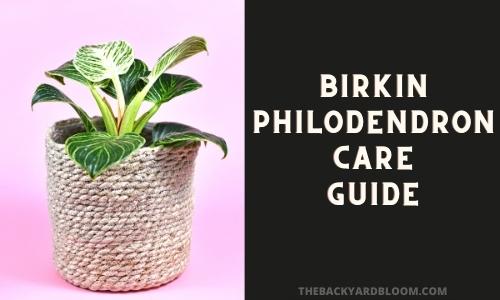
Plant Care Guide for the Birkin Philodendron
- Do not allow soil to completely dry out.
- Keep humidity levels higher than normal.
- Keep in a brightly lit area out of direct sunlight.
- Fertilize during the spring and summer.
- Repot at the end of the growing season.
How To Water a Birkin Philodendron
You want to make sure you don’t overwater your plant. Like many others in the philodendron family, the Birkin Philodendron can be touchy when it comes to getting too much water.
Test your soil moisture levels by sticking your finger into the soil a few inches to make sure it is dry before watering. If you prefer not to test the levels using your finger you can also use a moisture meter.
Birkin Philodendrons can be drought resistant but it is best to not let the all of soil medium dry out all the way between watering. Only the top few inches should be allowed to get dry.
Most people find that their Birkin Philodendron requires watering twice a week. But many factors such as temperature and humidity levels can change the needs of your plant so be sure to pay attention to the soil moisture levels.
When watering your plant (or any plant in your house) always allow the water to get to room temperature. Using cold water can cause shock and damage to the root system of a plant.
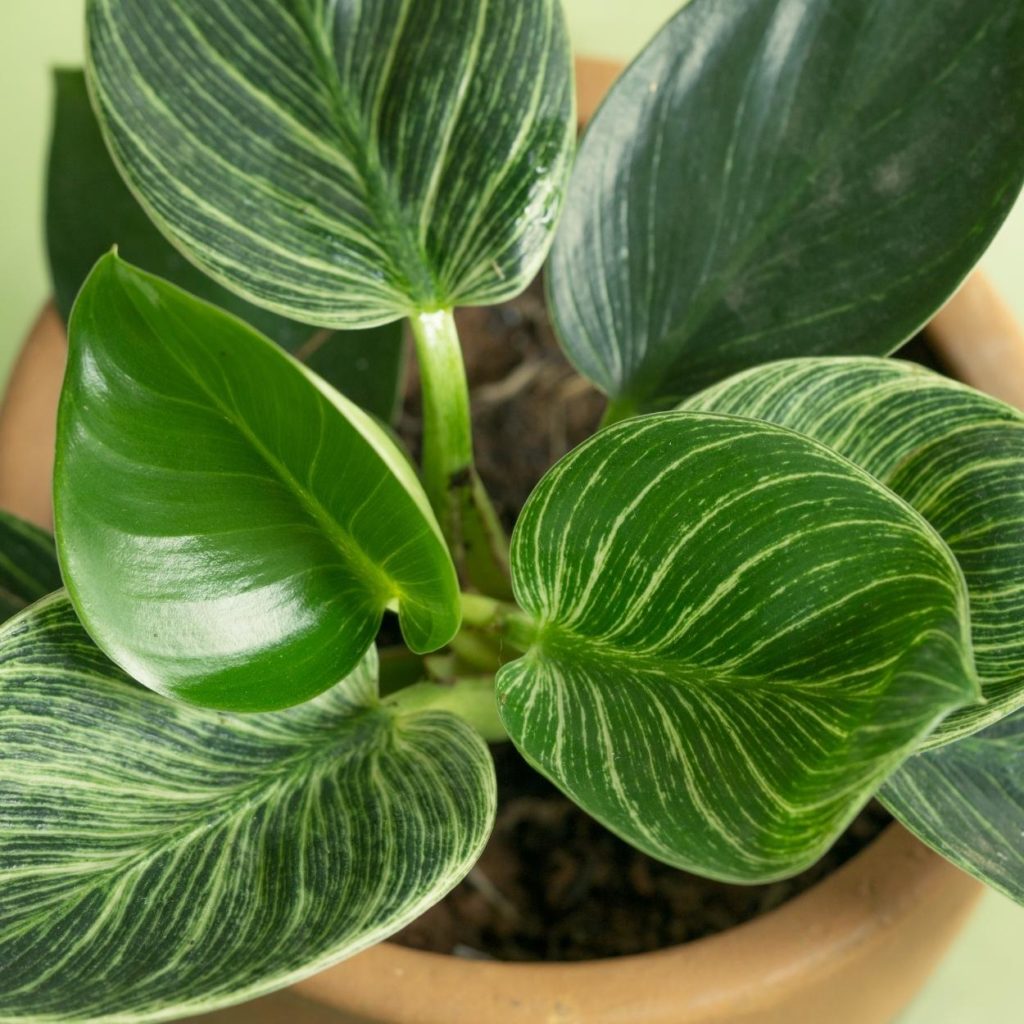
Birkin Philodendron Plant Light Requirements
Birkin Philodendrons do best in bright indirect light (indirect light is essential). East or west-facing windows are ideal for this plant.
Direct sunlight can cause issues with the leaves, burning them and making them fall off. It can also make the plant dry up too fast causing wilting.
Not enough light can cause the plant to grow leggy. This can cause too much space to be between the leaves as it grows and the plant stems will sag.
Light levels can also affect the variegation of the leaves. Plenty of indirect bright leaves will give you the beautiful bright cream pinstriped variegation. Too low levels of light can cause less variegation in the leaves.
If you find you don’t have a spot that is ideal for the light requirements you can always opt to use a grow light. If you do use one of these for your plant you want to give your plant at least 12 hours of light each day. Do not leave the grow light on all the time.
What Soil to Use with Birkin Philodendron Plants
Peat-based soil is best for Birkin Philodendrons. You want well-draining soil that also is able to hold moisture without getting soggy.
Perlite (What is Perlite for?) can be added to peat-based soil to help with aeration and drainage of the soil medium.
The Best Type of Pot for a Birkin Philodendron
Getting a well-draining pot is essential to keeping a healthy plant. Just like most houseplants, Birkin Philodendrons can get root rot if left sitting in soggy soil that doesn’t drain.
Terracotta plants and unglazed clay pots can dry out the soil very fast and is not a good option for these plants since they need a bit more moisture and the soil should not dry out fully between watering.
Repotting a Birkin Philodendron
Birkin Philodendrons are a fast-growing plant, so you might find you will need to repot yours more often than other houseplants that you have.
Most often, people find that at the end of every growing season they need to get their plant a bigger pot. When you get a new pot for your Birkin, pick one that is 1 to 2 inches bigger than the current pot that it is in. Do not get one that is too big, if you do you risk having too much moisture being retained in the unused soil and root rot could set in.
Pull your plant out of its current pot and inspect the roots to make sure you don’t see any damaged ones. If you do find damaged roots when you are repotting your plant, this is the best time to remove the damaged portion.
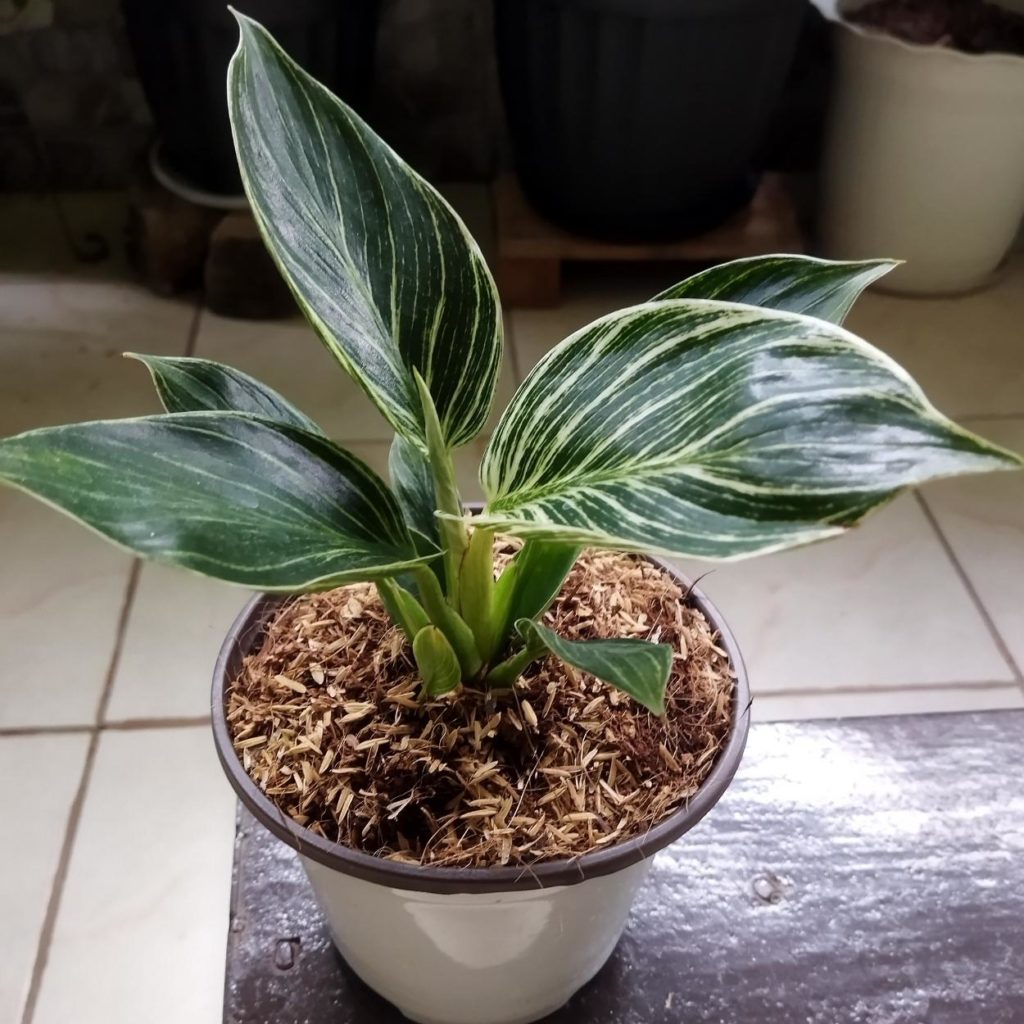
Birkin Philodendron Plant Propagation
Birkin Philodendrons can be propagated with cuttings or by separating any off-shoots.
When you go to propagate your plant it is best to wait for its growing season, during the spring or summer. This way you are propagating the plant when it is strongest and most prone to grow well.
To get a cutting you need to cut off part of the plant at a stem. Remove all but one to two leaves from the stem. Place this into a pot with a moist soil medium. You should keep the cutting during this time in indirect sunlight and keep the humidity levels up.
After about three weeks you should start to see sprouting on the cutting with new leaves growing soon after.
To propagate a Birkin Philodendron by separating an off-shoot. You will want to take the entire plant out of its pot and separate the smaller off-shoot from the parent plant. Put the parent plant back in the original pot with some extra soil to replace the area that the off-shoot was located. Pot the off-shoot in it’s own pot and care for it like you would the parent plant.
Birkin Philodendron Toxicity and Pets
According to the ASPCA many philodendrons are toxic to pets. While they do not list the Birkin Philodendron specifically, since it is a newer plant it is safe to assume that this Philodendron is also toxic when ingested. All Philodendrons have calcium oxalate crystals. These crystals are toxic if they get ingested (this includes humans, so don’t eat your plant either). Make sure to keep these away from your pets.
If you do have trouble keeping your pets from munching on your plants you can make a citrus spray using lemon juice to spray on your plants or purchase a premade spray like Bitter Apple to deter your pet from chewing on your plants.
Fertilizing a Birkin Philodendron
Birkin Philodendrons should be fertilized in their growing seasons, during the spring and summer.
Use a liquid fertilizer for houseplants and follow the directions for the fertilizer. These plants tend to grow a pretty moderate rate so fertilizing during the growing season is essential.
Temperature Needs
Birkin Philodendrons are a tropical plant, this means that they like warmer temperatures.
Temperatures should stay in a range of 55°F – 85°F for the plant to do its best.
Humidity
Like many tropical plants, the Birkin Philodendron prefers humidity levels that are above average (50% – 70%).
If you find the area where you keep your plant is too dry for its liking you can help increase the humidity levels around the plant by grouping it with other plants.
You could also use a pebble tray with water under the plant. When the water evaporates it will provide humidity directly from under the plant. This can also help keep water from accumulating and staying in the soil.
Greenhouse cabinets are another popular option among plant lovers. With these, you can keep better control of the environment the plant is in and keep the humidity levels higher than the rest of the house.
Another option is to use a small humidifier in the area. This is a great option if you have numerous plants that need higher humidity and you can keep them all close to each other with the humidifier.
Misting your plant is also a tactic that can be used to keep humidity levels high enough.
Pruning Birkin Philodendron Plants
You shouldn’t need to do much pruning on a Birkin Philodendron.
Just make sure to remove any damaged or dead leaves from the plant as you see them.
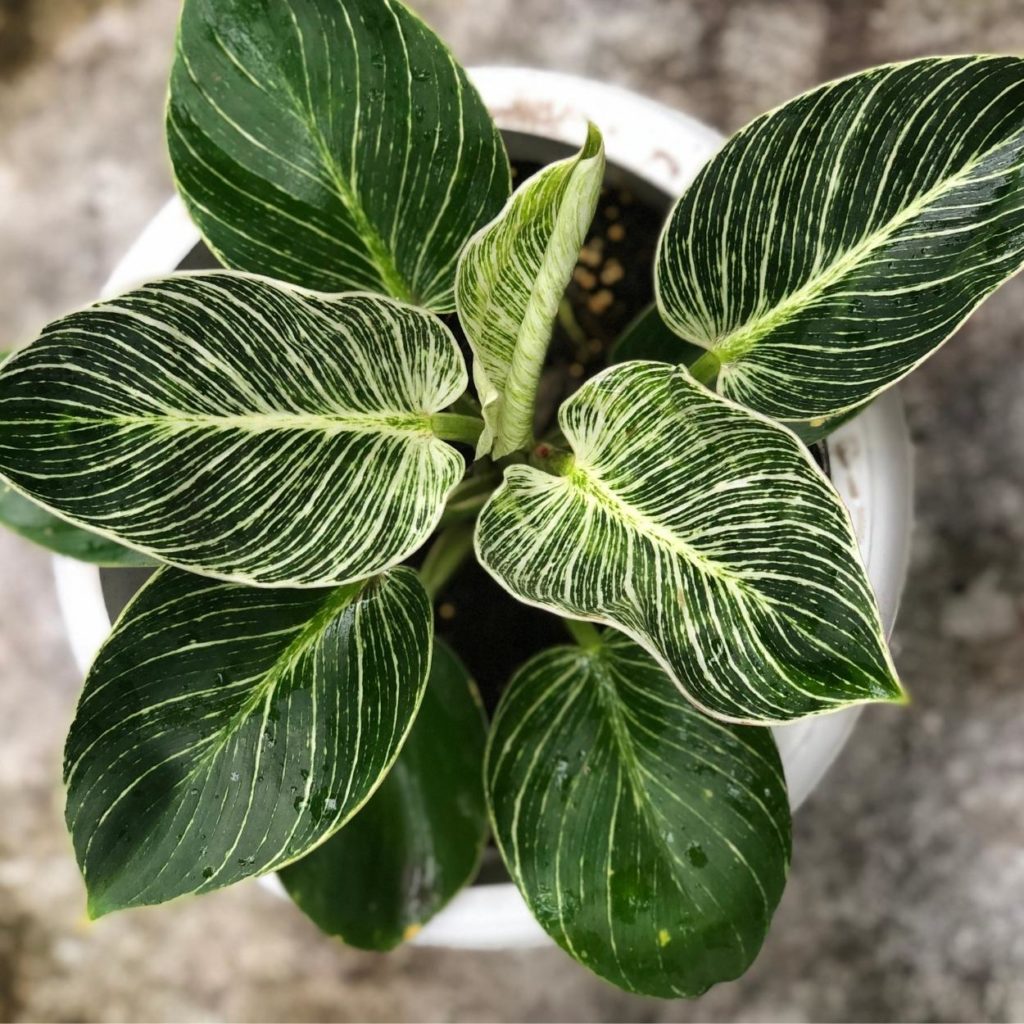
Common Problems With Birkin Philodendron Plants
Spider Mites
One way to help keep spider mites away from your plant is to keep the humidity levels high. Spider mites don’t like humid environments, they prefer drier environments. So by making sure your Birkin Philodendron is in optimum humidity levels for the plant you can help it ward off spider mite infestations.
If you do happen to get spider mites you will probably first notice webbing appearing on the undersides of the plant leaves.
The first thing you need to do is remove your plant from the area it is in and isolate it so you can protect your other plants.
Then rinse the leaves off with cool water, you can do this in the sink or with a cloth rag.
Remove any damaged foliage, you will see yellowing or brown leaves. Cut these off.
You will then want to wipe the plant down with neem oil, or you can spray the neem oil on the plant if you prefer. If you do not like neem oil (it can have a pungent odor) you could also use an insecticidal soap spray.
Yellow Leaves
Yellow leaves on a Birkin Philodendron most often indicates that overwatering is happening or that too much water is being retained.
Check the soil you are using, it could be that it is retaining too much water. Use peat-based moss that drains well and will not hold onto too much moisture.
Also, make sure that the pot you chose for your plant has drainage. Without drainage in the pot, no matter what type of soil you use it will not drain properly for your plant.
If the pot is too big for the plant this could also be a cause for yellow leaves. Having the plant in a pot that is not the right size allows for extra moisture to sit in the soil and not be used by the roots.
To fix overwatering, ensure that the plant is in the right size pot, has the right soil, and allow the soil to dry out before watering again.
If you find that root rot has set in you will need to repot your plant and remove any diseased roots from the plant before putting it in new soil.
Brown Leaves
Brown leaves on a Birkin Philodendron usually indicate that the plant is too dry. This can be due to not getting enough water and/or not enough humidity.
Make sure that you are not allowing the soil to fully dry out between waterings and that the humidity levels are adequate. If the humidity is too low consider a small humidifier or using a pebble water try under the plant.
Frequently Asked Questions About Birkin Philodendrons
You can find a Birkin Philodendron online, at local plant nurseries, and at times in big box stores such as Lowes. One popular place online to find these is Etsy. Many individuals propagate their own plants and sell them on Etsy now and you can find some good deals for rare plants there.
Birkin Philodendrons are becoming easier to find thanks to their popularity. They are still one of the house plants that you have to look carefully for and are not available everywhere.
Birkin Philodendrons do best with humidity levels between 50% to 70%. Getting closer to the higher end of the humidity range is best for these plants. If you find that you are having a hard time keeping the humidity levels up at acceptable levels pebble water trays or humidifiers can be used to increase the humidity.
Philodendron Birkins love higher humidity levels. You can mist your plant to help keep humidity levels on the higher end of the range of 50% to 70%.
The most common cause of yellowing Philodendron Birkins is overwatering. Check your soil moisture levels and make sure that the top few inches of the soil are dry before you water your plant. You don’t want to allow all of the soil to dry out, but when the first couple of inches have dried it is time to water the plant again. Also, make sure that you have a pot that allows for drainage and a soil mixture that doesn’t hold onto too much water.
No, a Birkin Philodendron cannot live in water. While you can start cuttings in water, you cannot let the plant sit in water all the time. Doing this would lead to root rot and would kill the plant.
Birkin Philodendrons need indirect light, not direct sunlight. You can also use a grow light if you don’t have an area that will provide bright indirect sun. You should give your Birkin at least 12 hours of light each day. If using a grow light do not leave it on 24/7.
Philodendron Birkins are not a climbing plant. They are self-supporting and can grow up to 2 or 3 feet tall.
Since Philodendron Birkins are a result of a mutation from another type of Philodendron it can revert back to the Rojo Congo colors.
Yes, if ingested Birkin Philodendrons can cause toxicity due to the calcium oxalate crystals that are in the plant. Keep this and all philodendrons away from pets.
